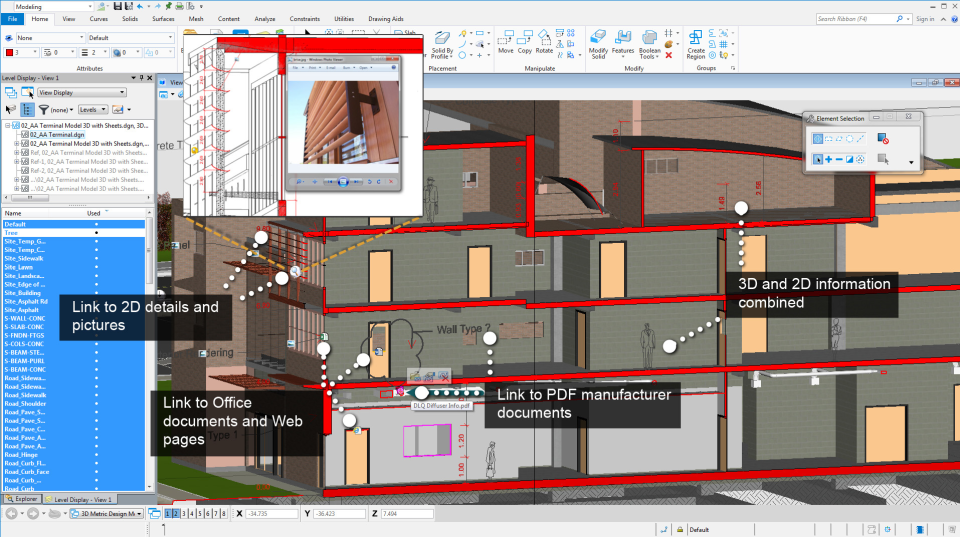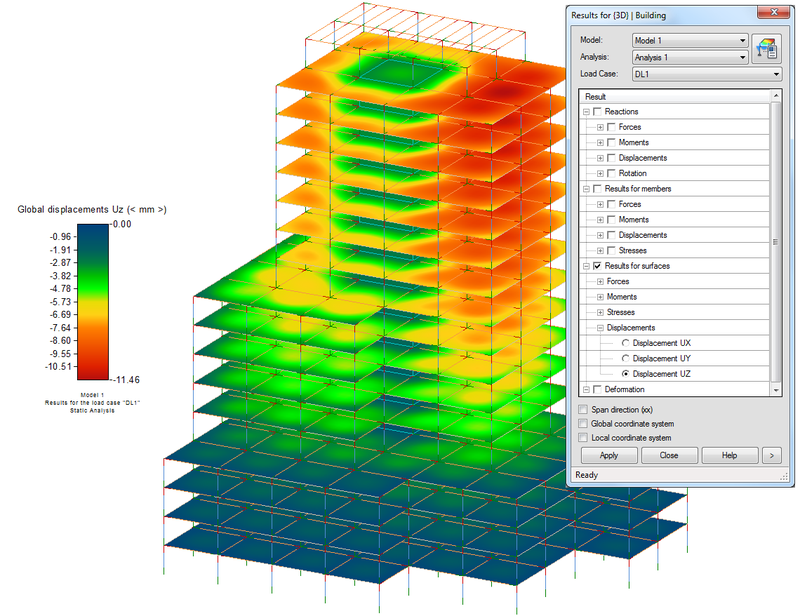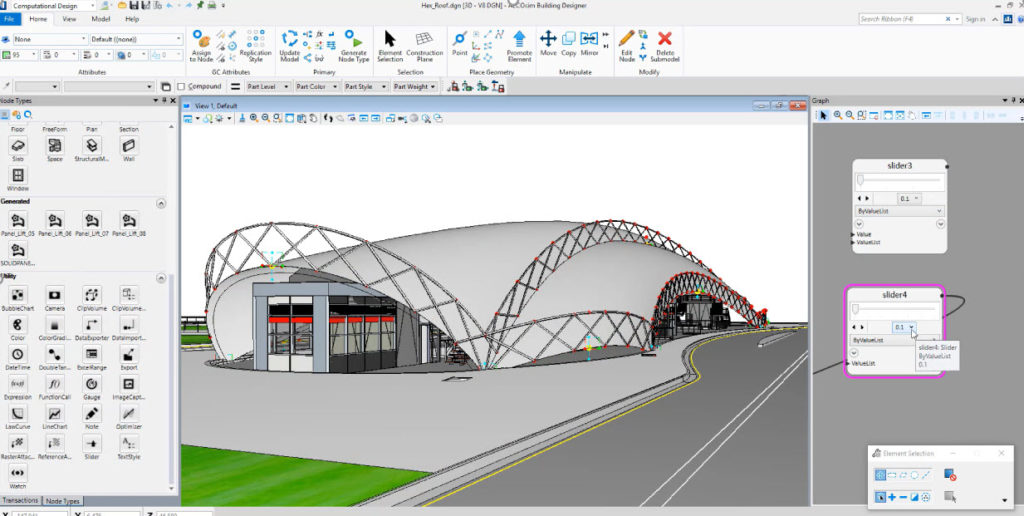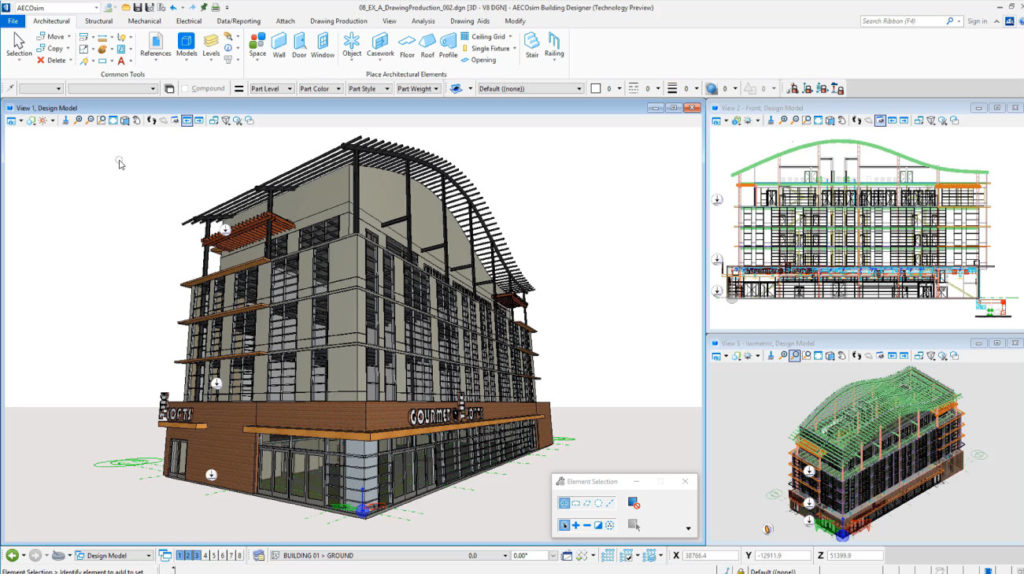Building Information Modelling (BIM) | OpenBuildings
Integrate multiple disciplines – from Architects (AEC) to Electrical, Mechanical (MEP), and Structural Engineers – to successfully Design, Analyze, Construct, and Manage buildings of all types and scales. With OpenBuildings software, you can deliver sustainable, high-performance buildings faster and with ease.
- Design buildings and facilities
- Analyze building system performance
- Collaborate across multi-discipline teams
- Generate documentation and report






TECHNICAL OVERVIEW:
All Disciplines
- Design in 3D to explore ideas with free-form modeling
- Design in context with referenced reality models and point clouds
- Perform clash detection
- Produce lifelike renderings, visualizations and movies
- Apply company and project standards
- Exchange data in common formats (i.e. IFC, COBie, RealDWG, Revit Family RFA, and SketchUp SKP)
- Incorporate project documents, media, web links, and more with hypermodeling
- Easily manage data with bidirectional editing in Microsoft Excel
- Share project information with iModels
- Enforce production standards within a ProjectWise managed environment
- Automate coordinated drawings by controlling drafting styles and annotations
Architectural
- Speed up design by using a catalog of walls, doors, windows, and furniture
- Manage floor definitions for reference planes and floor groups
- Define custom grid systems
- Manage spaces to ensure compliance with owner requirements
- Model custom design stairs and handrails
- Interactively design configurations of curtain walls
Structural
- Model detailed steel structures, trusses, bar joists, handrail, and ladder assemblies with ProSteel elements
- Model concrete and timber structures
- Reference a comprehensive library of international steel and concrete shapes
- Produce quantity reports and volume and weight analyses
- Share structural models and analysis using Bentley’s Integrated Structural Modeling (ISM) technology
- Exchange data with detailing applications using industry standards (i.e. CIS/2, and SDNF)
Mechanical
- Route multiple pipes simultaneously with different diameter, spacing, end type, insulation, and with manufacturer catalog
- Parametrically model HVAC, piping, and plumbing systems
- Define components, paths, and angles to be modeled automatically when completing connections in HVAC and piping systems
- Dynamically route pipe systems with slope applied or apply as a post process
- Create and configure air handling units using standard modules
- Size ductwork based on air flow, velocity, and friction rate
- Export designs to Trimble’s FabShop for fabrication
Electrical
- Streamline lighting design using smart symbol arrangement tools that are aligned with ceiling grid and wall-mounted components
- Design electrical circuits and associate with lighting, power, or fire protection panels
- Automatically label components with user-definable labeling formats for switch designation, circuit numbers, and device IDs
- Model cable trays, baskets, conduits, and wireways
- Evaluate lighting level with a bidirectional interface with Relux lighting analysis
- Produce drawings and block diagrams, lighting, cable, and panel schedules based on user-definable templates
Computational Design
- Define objects, assembly relationships, and dimensional constraints to capture design intent to explore a broad range of what-if scenarios
- Use visual programming techniques to create design solutions, manage dependencies, and orchestrate behaviors between design objects
- Use mathematical statements to control geometry and define dependencies between design objects
- Create reusable geometric assemblies extending the range of geometry with embedded intelligent behaviors
- Define input controls (i.e. sliders and law curves) to dynamically manipulate design components and propagate change within the design
- Play the design script forward and in reverse incrementally to visualize the design intent and behaviors of design relationships
Energy Simulation
- Perform whole building energy analysis with analytical space models and conceptual mass models using industry-standard EnergyPlus
- Calculate design and satisfy building regulation requirements using industry-standard building load calculation methods (i.e. ASHRAE, PartL, and CIBSE)
- Reference a catalog of predefined standard HVAC system templates
- Calculate daylight factors using industry-standard Radiance engine
- Model surrounding buildings to simulate the effect of their shade on the design
- Create reports and charts for all aspects of building simulation including heating and cooling loads, LEED compliance, annual energy use, equipment sizing requirements, and CO2 emissions
